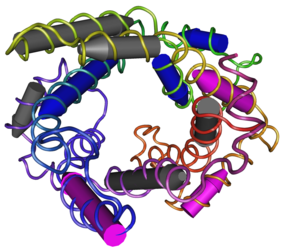| Revision as of 00:31, 12 June 2013 editWolfmanSF (talk | contribs)Autopatrolled, Extended confirmed users, Pending changes reviewers156,372 editsm -> lower case← Previous edit | Revision as of 17:11, 11 July 2013 edit undoMiscellaneous131 (talk | contribs)68 edits Hormones that increase the expression of uncoupling proteinsNext edit → | ||
| Line 10: | Line 10: | ||
| * ], also known as "UCP5" | * ], also known as "UCP5" | ||
| Uncoupling proteins play a role in normal physiology, as in ], because the energy is used to generate heat (see ]) instead of producing ]. However, other substances such as ] and ] also serve the same uncoupling function, and are considered poisonous. ] is also an uncoupling agent and will deplete the body of ATP and increase body temperature if taken in excess.{{citation needed|date=December 2010}} | Uncoupling proteins play a role in normal physiology, as in cold exposure or ], because the energy is used to generate heat (see ]) instead of producing ]. However, other substances such as ] and ] also serve the same uncoupling function, and are considered poisonous. ] is also an uncoupling agent and will deplete the body of ATP and increase body temperature if taken in excess.{{citation needed|date=December 2010}} Uncoupling proteins are increased by ], ], ], and ].<ref>{{cite journal |author= Gong DW, He Y, Karas M, Reitman M |year=1997 |title= Uncoupling protein-3 is a mediator of thermogenesis regulated by thyroid hormone, β3-adrenergic agonists, and leptin|journal= J Biol Chem |volume=272 |issue=39 |pages=24129-32| url=http://www.jbc.org/content/272/39/24129.full}}</ref> | ||
| ==References== | ==References== | ||
Revision as of 17:11, 11 July 2013

An uncoupling protein is a mitochondrial inner membrane protein that can dissipate the proton gradient before it can be used to provide the energy for oxidative phosphorylation.
There are five types known in mammals:
- UCP1, also known as thermogenin
- UCP2
- UCP3
- SLC25A27, also known as "UCP4"
- SLC25A14, also known as "UCP5"
Uncoupling proteins play a role in normal physiology, as in cold exposure or hibernation, because the energy is used to generate heat (see thermogenesis) instead of producing ATP. However, other substances such as 2,4-dinitrophenol and CCCP also serve the same uncoupling function, and are considered poisonous. Salicylic acid is also an uncoupling agent and will deplete the body of ATP and increase body temperature if taken in excess. Uncoupling proteins are increased by thyroid hormone, norepinephrine, epinephrine, and leptin.
References
- Nedergaard J, Ricquier D, Kozak LP (2005). "Uncoupling proteins: current status and therapeutic prospects". EMBO Rep. 6 (10): 917–21. doi:10.1038/sj.embor.7400532. PMC 1369193. PMID 16179945.
{{cite journal}}: CS1 maint: multiple names: authors list (link) - Gong DW, He Y, Karas M, Reitman M (1997). "Uncoupling protein-3 is a mediator of thermogenesis regulated by thyroid hormone, β3-adrenergic agonists, and leptin". J Biol Chem. 272 (39): 24129–32.
{{cite journal}}: CS1 maint: multiple names: authors list (link)
External links
- Uncoupling+Agents at the U.S. National Library of Medicine Medical Subject Headings (MeSH)
| Mitochondrial proteins | |||||||||||
|---|---|---|---|---|---|---|---|---|---|---|---|
| Outer membrane |
| ||||||||||
| Intermembrane space | |||||||||||
| Inner membrane |
| ||||||||||
| Matrix |
| ||||||||||
| Other/to be sorted | |||||||||||
| Mitochondrial DNA |
| ||||||||||
| see also mitochondrial diseases | |||||||||||
This biochemistry article is a stub. You can help Misplaced Pages by expanding it. |